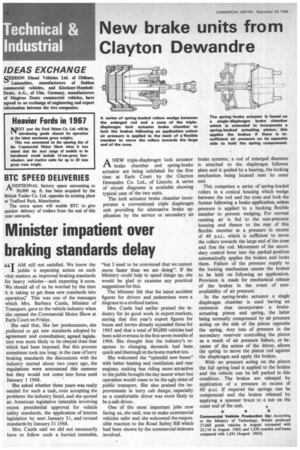New brake units from Clayton Dewandre
Page 64

If you've noticed an error in this article please click here to report it so we can fix it.
ANEW triple-diaphragm lock actuator brake chamber and spring-brake actuator are being exhibited for the first time at Earls Court by the Clayton Dewandre Co. Ltd., of Lincoln. A series of circuit diagrams is available showing typical uses of the two units.
The lock actuator brake chamber incorporates a conventional triple diaphragm unit providing for alternative brake application by the service or secondary air brake systems; a rod of enlarged diameter is attached to the diaphragm follower plate and is guided by a bearing, the locking mechanism being located near its outer end.
This comprises a series of spring-loaded rollers in a conical housing which wedge between the rod and the cone and lock the former following a brake application, unless pressure is applied to a backing flexible member to prevent wedging. For normal running air is fed to the non-pressure housing and thence to the rear of this flexible member at a pressure in excess of 40 p.s.i., which is sufficient to move the rollers towards the large end of the cone and free the rod. Movement of the secondary control lever into the parked position automatically applies the brakes and locks them. Failure of the pressure supply to the locking mechanism causes the brakes to be held on following an application. Provision is made for mechanical release of the brakes in the event of nonavailability of air pressure.
In the spring-brake actuator a single diaphragm chamber is used having an extension that incorporates a brakeactuating piston and spring, the latter being normally compressed by air pressure acting on the side of the piston opposite the spring. Any loss of pressure in the secondary reservoir controlling the piston as a result of air pressure failure, or because of the action of the driver, allows the spring to move the piston rod against the diaphragm and apply the brakes.
With no pressure acting on the piston the full spring load is applied to the brakes and the vehicle can be left parked in this condition. The brakes are released by application of a pressure in excess of 60 p.s.i. If required the springs can be compressed and the brakes released by applying a spanner brace to a nut on the outer end of the unit.
Commercial Vehicle Production Up: According to the Ministry of Technology, Britain produced 27,668 goods vehicles in August compared with 25,116 in August 1965; and 1,529 coaches and buses compared with 1,241 (August 1965).
















































































































































































































